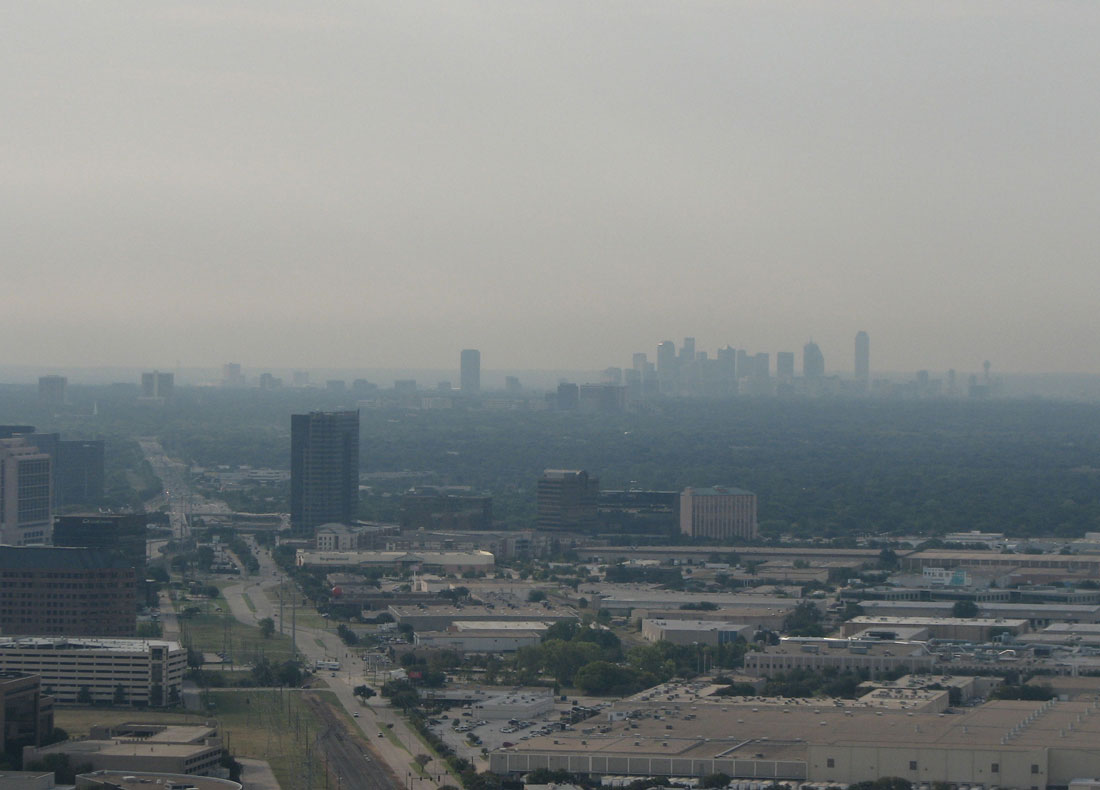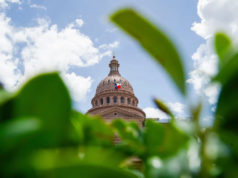If air pollution worsens and nobody hears a sound from state regulators, do we still get asthma?
OK, so it’s a bad joke, but without Texas’ citizen environmental watchdogs, you’d never know why pilots have visibility problems flying to the Metroplex or why doctors see more patients in the ER on bad-air days.
Nov. 1, for example, was a benchmark for the Texas Commission on Environmental Quality’s latest plan to reduce air pollution in North Texas. The agency’s regulators had said that this summer would bring the nine-county area into compliance with the Clean Air Act for the first time in 20 years.
The agency didn’t make a sound when the summer died a smoggy death, but the watchdogs certainly did.
TCEQ has “reached new heights of egregiousness” in ignoring air pollution, said Rita Beving, the North Texas organizer for Public Citizen, a consumer advocacy group.
“They always devise it to such a way that if the earth and the moon and the stars all align, we could get there,” Beving said. “Which is ridiculous, because when you’re trying to regulate so many industries, you can’t get there. And they know that.”
In other words, the results this year are depressing to fans of clean air –– Dallas-Fort Worth remains one of the most polluted metropolitan areas in the country.
TCEQ has air monitors placed throughout North Texas to record ozone levels. This year, six of the 19 monitors recorded smog at levels as bad or worse than allowed by a 1997 federal standard. What’s more, that standard has already been replaced by a more stringent one that the region is even less likely to meet.
The agency claims that all of the region’s monitors will meet the 1997 standard by next year, but based on the amount of pollution this year, there is “almost zero chance” that will happen, said Jim Schermbeck, director of Downwinders at Risk (and perennial pain in the ass to state regulators).
“If they claim there’s going to be some kind of spectacular turnaround, I want to see evidence for that,” Schermbeck said. “We knew they weren’t going to be drawing attention to the fact that their clean air plan failed.”
Of course, TCEQ doesn’t see things that way.
Spokesman Terry Clawson pointed out that 13 of the area’s 19 monitors recorded less smog than last year. And the three-year average of the worst smog readings was 87 ppb (parts per billion) this year compared to 90 ppb in 2011. The state agency had predicted all monitors would record smog at or below 85 ppb.
“We continue to evaluate ozone in the DFW area and review years of monitored data,” Clawson said in an e-mail.
Schermbeck remained unimpressed.
The agency doesn’t get credit for a “moral victory” just because some of the monitors saw less pollution than in 2011, he said. The reality is that air pollution in North Texas has been hovering around the same levels for years, inching up or down but never substantively improving, he said.
“It’s trying to bullshit their way to an answer for a reporter,” Schermbeck said.
Another TCEQ spokesman, Lisa Wheeler, said the agency actually has until June 2013 to come into compliance with the older 1997 standard.
Technically, that’s true, but it’s like “waiting for the clock to run out” because they can’t count data from next summer, said Schermbeck. Basically, they’ve already failed to meet their goals, but the referee hasn’t called the game yet.
“It’s just very insincere and very cynical,” he said. “They know they can’t count any data from next year.”
To bring Texas into compliance with the Clean Air Act, TCEQ must reduce pollution in the North Texas region to 75 ppb (the newer standard) by 2018. The latest results make it even less likely that will happen, he said.
If there’s a reason progress has stalled on cleaning up air pollution in the Metroplex, Schermbeck and others are pretty sure it has a lot to do with the gas wells, cement kilns, and coal-fired power plants that continue to operate with little meaningful oversight from the state.
So how was the air ever going to get cleaner without effective regulation of these industries? Well, TCEQ had an answer. As the economy continued to improve, Metroplex residents would buy newer, cleaner–running cars and sell the older, dirtier ones, resulting in less air pollution for the whole area.
It’s clear from this year’s numbers that isn’t going to happen, said Beving, who has spent more than 10 years working with the North Central Texas Council of Governments to curb pollution.
Her experience with TCEQ hasn’t made her an optimist.
The TCEQ plan that estimated lower pollution levels this year was never going to work because the 17,000 gas wells in the region are not seriously taken into account, Beving said. Perhaps the apathy about industrial pollution is not surprising given that the last 18 months of presidential campaigning have lacked any serious conversation about the environment or climate change, she said.
“What is it going to take for this state agency to wake up? For the EPA to [exert] their authority over air issues?” she said. “Because they have no desire to really enforce the rules.”
TCEQ spokespersons argued that a broader look shows the agency has reduced pollution from much higher levels.
Just nine years ago, the three-year average for ozone pollution was around 100 ppb, so “the area has made considerable progress,” Clawson said.
It’s hypocritical, however, for the agency to take credit for those gains, said Schermbeck. That “progress” is the result of higher environmental standards for cars, which TCEQ initially fought against, and not because of the agency’s planned methods for reducing pollution, he said.
“Progress has been made over the past 10 or 20 years. Nobody’s doubting that progress overall has been made,” Schermbeck said. “Over the last few years, that’s another story.”
The biggest problem is that much of the pollution in Dallas-Fort Worth isn’t produced here, but drifts in from the Midlothian cement plants south of the Metroplex and from coal-fired power plants in East Texas.
Those two industries are the largest source of smog-forming chemicals in North Texas, said Neil Carman, the clean air program director for the Texas Sierra Club and formerly a veteran inspector for TCEQ.
“The number of coal-boilers contributing to the problem in DFW is immense,” Carman said. “It would be like a bunch of people driving a bunch of smoke-belching Model Ts across Dallas, except these are immense. Until the agency addresses what to do with these plants, they’re not going to clean up the air.”
So far, TCEQ’s strategy has been to hold consumers accountable for the pollution coming out of their exhaust pipes while ignoring the industries that create as much or more of the pollution filling the air, Carman said.
“The children and the elderly and people with breathing problems are suffering because the agency is not doing its job,” he said.













I wonder what the The Fort Worth regional air quality would be like IF the un natural gas drilling was at it’s peak still like prior to 2008. I guess we should thank GOD for some small gifts in that the price for the gas has caused the gas drillers to curtail their activities by nearly 90 %. We are lucky we do not have the originally predicted 10,000 wells in Fort Worth, TX and have just shy of 2,200 and many of them are shut in or low production currently. WIll it increase back to post 2009 production? Do not know right now. BUT surfice to say the gas operators still today refuse to incorporate any emssions controls. One look at a recent video can show residents what these sites release into our neighborhoods from gas wells, production water holding tank batteries and compressor stations. What you Don’t See Can Harm You http://www.youtube.com/watch?feature=player_detailpage&v=ROaoKCK0GS4
If only the drillers can find out how the Handley Power Station, facility# 3491 reduced their emissions……http://ampd.epa.gov/ampd/ …..go to instructions, get maps and reports, type in your zip/interactive map, to see a HUGE IMPROVEMENTin S02 and NOX (respectively)….
1997 33 tons 4,774 tons
1998 12 4,871
1999 13 3,301
2000 141 3,684
2001 48 2,005
2002 8 2,022
2003 10 937
2004 4 211
2005 3 61
2006 3 59
2007 2 21
2008 2 29
2009 2 39
2010 1 46
2011 3 56
I wonder if the Handley big improvement was employing emission control devices?
Gee the oil and gas industry would never $pring for any of those…..geesh!
If only the drillers can find out how the Handley Power Station, facility# 3491 reduced their emissions……http://ampd.epa.gov/ampd/ …..go to instructions, get maps and reports, type in your zip/interactive map, to see a HUGE IMPROVEMENTin S02 and NOX (respectively)….
1997 33 tons 4,774 tons
1998 12 tons 4,871 tons
1999 13 tons 3,301 tons
2000 141 tons 3,684 tons
2001 48 tons 2,005 tons
2002 8 tons 2,022 tons
2003 10 tons 937 tons
2004 4 tons 211 tons
2005 3 tons 61 tons
2006 3 tons 59 tons
2007 2 tons 21 tons
2008 2 tons 29 tons
2009 2 tons 39 tons
2010 1 tons 46 tons
2011 3 tons 56 tons
I wonder if the Handley big improvement was employing emission control devices?
Gee the oil and gas industry would never $pring for any of those…..geesh!